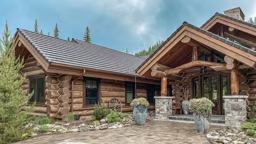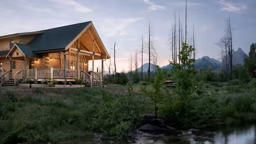
When people contemplate the idea of a “forever home,” many assume that they’ll be empty nesters looking to downsize to a less expensive, more manageable house.
But what if your nest isn’t so empty after all? What if your grown children want to move back due to post-college debt, divorce or simply to be closer to you? And what happens if your aging parents can no longer live safely on their own but don’t want to reside in an assisted living facility? Will you have the capacity to take them in?
You can accommodate all these scenarios when multi-generational design is part of your “forever home” plans.
Who Needs a Multi-Gen Home?
In the U.S., the South and Southwest have the highest concentration of multi-gen households, while the Midwest states are the least likely to hold several generations under one roof. But according to research distillery Stacker, the tiny state of Hawaii tops the charts as having the largest number of multi-gen abodes, with nearly eight percent of households sheltering everyone from grandparents to aunts and uncles.
For Hawaiians and other populations, living with your extended family is a cultural norm; for others, the decision to cohabitate across age groups stems from purely economic or healthcare reasons. Whatever the motives, multi-gen housing is a trend on the rise.
In a study conducted by Pew Research Center, a record 64 million Americans (20 percent of the U.S. population) lived in a multi-generational household in 2016, despite an improving economy. This led experts to believe the decision is as much a lifestyle choice as a financial decision.

Multi-Gen Design
Whether the reason is a desire to have your grown children and grandkids close to you or the ability to keep an aging parent out of a nursing home, if you’re looking for a home that can accommodate several generations in simultaneous comfort, we offer four key elements to ponder as you’re designing it.
Design ahead of your needs.
Consider who may be living there. The needs of elderly parents will be far different than kids moving back home after college. Some families require quarters for a live-in caretaker who will need easy access to their charge while maintaining independence. Others may have relatives from abroad who live with them for extended periods of time. The design requirements for each of these scenarios is different but can be met with thoughtful examination of future possibilities and careful planning.
Provide separate entrances.
A very important, yet oft overlooked, aspect in multigenerational home design is how occupants will enter and exit the home. It’s a good idea to incorporate a separate entrance for each generation. Not only will this reduce traffic throughout the day and minimize noise at night, it also will provide everyone in the family with a sense of autonomy.
Make two masters on the main.
Michael Grant, co-owner of Georgia-based Modern Rustic Homes, says that a huge design trend he sees is a request for two main-level master suites; which he refers to as the “senior” and “junior” masters.
“Should you have an aging parent who cannot navigate stairs come to live with you, a secondary master on the main level is a tremendous asset,” Michael explains, though he does offer a bit of design advice: “Locate them on opposite sides of the house. This allows each of you to maintain your privacy.”
And, until that day arrives, you can use this spare suite as what Michael refers to as “snore jail” — a space to comfortably yet acoustically distance a snoring partner so you can both get a good night’s sleep.
Foster togetherness and independence.
One of the best reasons for maintaining a multi-gen home is the way it brings the family together, but sharing a roof doesn’t necessarily mean spending every moment with each other. To minimize friction and give everyone a place to retreat, it’s vital to have your own space. Tactics can include adding an apartment above a garage, designing a dedicated wing or even devoting an entire level to your extra occupants. In addition to a separate entrance and a full master suite, be sure to include a kitchenette and dining space in the mix. Otherwise, it’s just a glorified guest room.
Build an ADU.
Accessory dwelling units (ADUs) go by a bevy of nicknames: in-law suite; carriage house; casita; guest nest. No matter what you call them, they’re a great way to add independent living quarters that are away from the primary home but still on the property.
Reasons to add an ADU range from seeking privacy for extended visitors to providing supplemental income by renting it out. But the most common and practical use is to keep loved ones nearby long term. And, when properly designed and built, having one can be a real boost to your property value.
As the founders of New Energy Works, a design-build company specializing in timber framing, Jonathan Orpin and Maxine Bromfield saw the practicality and benefits of adding an ADU to their Portland, Oregon, home so they built a 675-square-foot, one-bedroom timber cottage to complement their 3,000-square-foot primary residence. Both structures evoke a classic contemporary Northwest aesthetic, combining recycled building materials with energy-conservation strategies.
“Good design is one of the best ways to spend your money. Our ADU is stunning. There’s a sense of balance between the open floor plan and privacy offered with the bedroom, combined with natural patina of the industrial timbers we chose for the timber frame,” Jonathan explains.
Sometimes, ADU design is so good homeowners choose to live there instead. “We’ve had several clients downsize from a 2,500+ square-foot home to an 800- or 1,000-square-foot ADU on their land,” Jonathan says. “Then, they rent out their larger house to cover all their expenses and then some.
Unlike “tiny houses,” which are built to specifications used for mobile homes and have zoning restrictions, ADUs are built to the same residential code as the primary residence and are appraised and valued accordingly. Ownership of an ADU remains with whomever owns the primary home, and they are sold as one property, should the need arise.
A multi-generational household can be rewarding, affording you the ability to pass down family history, share hobbies and make memories that will last forever.

Leaving a Legacy: Planning for Future Generations
Preserving your house for future generations requires planning. In your heart, a legacy home belongs to your entire family. However, only the deed-holders are the true legal owners, and the form of ownership affects their rights to the property.
Attorney Sally Kane, Esq., defines the three common forms of real-property ownership to understand as you’re planning your home for today, tomorrow and always.
Tenants by the Entirety.
Married couples typically hold real property as tenants by the entirety. Under this type of deed, you and your spouse are equal owners, so when one dies, the other retains ownership. But many couples don’t consider that a surviving spouse may remarry, and if the surviving spouse then dies or divorces, his or her current spouse may have a claim to the property.
Joint Tenants with Right of Survivorship.
In this model, two or more people have an undivided, 100% interest in the property. When one owner dies, the other owners absorb the decedent’s interests. For example, if you were to deed the property to two siblings as joint tenants, the one to die first could not bequeath the house to her or his family, but instead the surviving sibling would acquire sole ownership, and the house would pass down that line.
Tenants in Common.
Tenants in common own individual shares in the property, which may be of unequal size and can be transferred to third parties through sale or inheritance. The percentage owned by one child could be subject to a creditor’s lien if the child acquires a large debt — a circumstance that could put the property in jeopardy. And, your child’s spouse could claim his or her share, should they divorce.
Pros and Cons of Multi-Gen Living
PROS
-
Increased family time. Foster closer relationships between grandparents, grandkids, aunts, uncles and cousins.
-
Help with household matters. This could cover everything from help with the cooking to built-in babysitting.
-
Enhanced safety. Chances are someone will be home to watch over the house the majority of the time. Plus, having elderly parents close by keeps them safer, too.
-
Financial stability. More occupants could mean more funds to cover household expenses.
CONS
-
Less privacy. The more people who live in the house, the harder it is to get a little alone time.
-
More housework. A full house results in additional cleaning, larger meals (more dishes) and extra loads of laundry.
-
Increased tensions. Trying to get everyone to agree on decisions — large and small — can be problematic.
Benefits of Putting a Home into Trust
A living trust, often referred to as an inter vivos trust, allows you to control the use, transfer, ownership and funding of your home during your lifetime and upon your death. The trust — not you or your children — owns the house. The trustee manages assets on behalf of the beneficiaries. You may act as both trustee and beneficiary. When you die, the remainder of the trust passes to those you name as beneficiaries to be managed by the person you appoint as trustee. This arrangement offers several advantages, including protecting the home from creditors; managing future expenses, including the mortgage and taxes; and keeping the peace in the family.
Floor Plan Ideas: A Plan for the Ages
P.s.– Browse hundreds of floor plans to find the one that's just right for your family!
Texas Timber by Golden Eagle Log & Timber Homes
Something as simple as having a kitchen on each floor allows you to transform a single-family home into a multi-gen abode. In addition to the kitchen, the lower level of this plan has almost everything it needs for total autonomy, including two bedrooms, living space with fireplace and a separate entrance. The only thing it shares with the level upstairs is the laundry. This is an ideal arrangement if adult children (and grandkids) come to live with you.
Nighthawk by Modern Rustic Homes
If you prefer to keep aging parents on the same level, especially as you sleep, design two bedroom suites — a senior master and a junior master — into your plans. By positioning them on opposite sides of the home, you can maintain privacy while remaining close by.
Eagle’s Nest by Modern Rustic Homes
By adding an elevator, you’ll provide older family members or those with mobility issues easy access to all areas of the home. Residential elevators have come down in price significantly and don’t need to be installed right away. Stacked closets (marked as E.S. on each level of this plan) can be converted to an elevator shaft when the time comes.











_11868_2024-09-17_08-44-256x288.avif)





